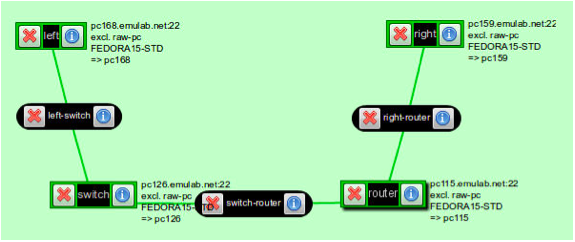| Version 3 (modified by , 11 years ago) (diff) |
|---|
TCP Experiment
Overview:In this experiment you will learn how to set up a firewall using OpenFlow. We will use the following network topology for this experiment:
|
|
Prerequisites:This tutorial expects that you have completed lab 0 and know how to create a new sliver with an existing rspec. If you have not completed lab 0 please do so now. |
Tools:All tools will already be installed at your nodes. This experiment uses OpenFlow and Open vSwitch. |
|
Where to get help:For any questions or problem with the tutorial ask your TA or Professor for help. If a GENI tool is not working correctly please email help@geni.net |
Set up
Download the RSPEC from http://www.gpolab.bbn.com/experiment-support/OpenFlowExampleExperiment/openflow-firewall-pc.rspec
Using Omni, Portal, or Flack, create a new sliver using this rspec on either ProtoGENI or InstaGENI. For ProtoGENI, use the Utah aggregate manager. On omni, this will need the command
-a pg-utah
Execute the Experiment
helpful tips
This section contains a few tips that may help you out if you are using the Open vSwitch implementation provided with this tutorial.
If you are using a hardware OpenFlow switch, your instructor can help you find equivalent commands.
The Open vSwitch installation provided by the RSpec included in this tutorial is located in /opt/openvswitch-1.6.1-F15. You will find Open vSwitch commands in /opt/openvswitch-1.6.1-F15/bin and /opt/openvswitch-1.6.1-F15/sbin. If you add these paths to your shell’s $PATH, you will be able to access their manual pages with man.
Note that $PATH will not affect sudo, so you will still have to provide the absolute path to sudo; the absolute path is omitted from the following examples for clarity and formatting.
- 2.1 ovs-vsctl
Open vSwitch switches are primarily configured using the ovs-vsctl command. You may find the ovs-vsctl show command useful, as it dumps the status of all virtual switches on the local Open vSwitch instance. Once you have some information on the local switch configurations, ovs-vsctl provides a broad range of capabilities to expand your network setup to more complex configurations for testing and verification. In particular, the subcommands add-br, add-port, and set-controller may be of interest.
- 2.2 ovs-ofctl
The switch host configured by the given rspec listens for incoming OpenFlow connections on localhost port 6634. You can use this to query the switch state using the ovs-ofctl command. In particular, you may find the dump-tables and dump-flows subcommands useful. For example,
sudo ovs-ofctl dump-flows tcp:127.0.0.1:6634will output lines that look like this:cookie=0x4, duration=6112.717s, table=0, n packets=1, n bytes=74, idle age=78,priority=5,tcp, nw src=10.10.10.0/24 actions=CONTROLLER:65535
This indicates that any TCP segment with source IP in the 10.10.10.0/24 subnet should be sent to the OpenFlow controller for processing, that it has been 78 seconds since such a segment was last seen, that one such segment has been seen so far, and the total number of bytes in packets matching this rule is 74.
- 2.3 Unix utilities
The standard ping and /usr/sbin/arping tools are useful for debugging connectivity (but make sure your controller passes ICMP ECHO REQUEST and REPLY packets and ARP traffic, respectively!), and the command netstat -an will show all active network connections on a Unix host; the TCP connections of interest in this exercise will be at the top of the listing. The format of netstat output is out of the scope of this tutorial, but information is available online and in the manual pages.
Exercises
Attachments (3)
-
design.png (6.1 KB) - added by 11 years ago.
design
-
execute.png (5.1 KB) - added by 11 years ago.
execute
-
finish.png (5.5 KB) - added by 11 years ago.
finish
Download all attachments as: .zip

